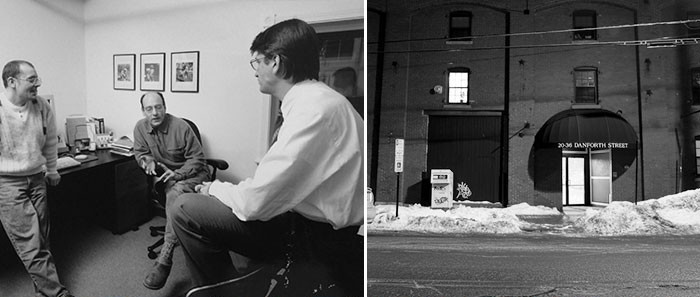Save 50% on a 3-month Digiday+ membership. Ends Dec 5.
“Embracing the dark art of RFPs,” and 3 other ways small digital shops scale

This piece is brought to you by Beagle – a new tool for agencies that makes it easier and faster to create more compelling proposals.
There is good news and bad news for small agencies operating in today’s amped-up digital environment. The good: A fractured media landscape means clients are questioning, and often reinventing, their agency strategy. This gives small shops a shot at large accounts, even if it is just a piece of the action.
The bad: These upstart agencies may not actually be prepared for the demands of winning new business in a way that encourages healthy growth.
“They say, ‘We’ll do great work and that will be our calling card and people will call us,’” said Matt Hofherr, director of strategy and co-founder at San Francisco-based MUH-TAY-ZIK | HOF-FER. “But if you’re small, they’re not going to ring the phone.”
And yet, new agencies launch every day. We asked four small- to mid-sized shops how they’re balancing the inbound versus outbound business, staffing their outreach and collaborating on pitches.
Embrace the rapid-fire RFP process
Answering RFPs can feel a bit like shoveling sand into a black hole: you answer, you file, you many never hear from them again. And — poof — here’s another and it’s due EOD.
Ad position: web_incontent_pos1

“I would never discourage a small agency from participating in RFPs,” said Hofherr. Digital has certainly turned up the pace of the RFP process, but it can make you a quick study of yourself.
“Potential partners can only ask you so many questions: What’s your business-to-business experience? What’s your take on integrated marketing?” After a year or two, the shop should have their best answers at the ready, “whether it’s in a folder called ‘RFP’ or ‘successful pitches.’”
Moreover, agencies should remember that clients value substance over style. When fledgling Copenhagen agency Hello Monday launched in 2008, it had a design-first new business strategy: pour hours into creating really beautiful proposals.
“It was a differentiator,” said Andreas Anderskou, group account director. But InDesign was tough to work in, they wound up with a lot of files, and, in the end, clients wanted substance more than style. “Now it’s more about getting to the point.”
Ad position: web_incontent_pos2
Get a seasoned new biz guy, just don’t call him that
“Small shops are usually started by creatives, and they’re not practiced at rejection,” said Stephen Fox,founder of Traverse in Portland, Ore., pictured right. At the very least, they’re not used to the constant, unrelenting rejection of a perpetually slamming door.

As an agency grows, it needs a partner practiced at new business.
“Agencies don’t like cold-calling, it feels icky,” said Hofherr, who leads new biz at MUH-TAY-ZIK | HOF-FER. “I don’t understand that. If I’m picking up the phone, I’m genuinely interested in you and your business problem.”
According to Hofherr, young shops will inevitably make certain mistakes. For example, “a lot of small agencies don’t know what to do with their materials. They’ll have no materials… Or they’ll have someone with new business in their title make the call. That’s when it feels icky,” he said.
Instead, Hofherr advises, “Have a strategist call, have a partner call.”
Make sure ‘new business’ calls on all corners
“Counter-intuitively when an agency is smaller, new business resides with a smaller group of people,” Leeann Leahy, president at Portland, Maine-based agency, Via. The agency has grown to 130 people since it was founded in 1993 with just three partners.

But small agencies that concentrate those efforts with just one or two executives run into problems. “You wind up creating two types of people within the agency: The people who are churning it, then passing it back to the people that are going to produce it,” Leahy said.
Instead, the new business process should be an inclusive one, with leads reaching out to specialists within their shop. At Via, Leahy nurtures current relationships and manages outreach, while a group account director coordinates new business efforts with input from agency specialists.

Hofherr’s shop does the same. New business sits with him and a single account executive who helps prepare the pitch, but the team contributing to those materials can include five or more others.
It’s an approach, they say, born of the new digital reality.
“Clients are now asking themselves, ‘Do I have one agency that does it all? What happens when I want to do a viral content experience?,’” Leahy said. Because of that fractured client approach to procurement, it’s necessary for Via to reach out to specialists.
“By creating a culture where we are all communicating, we can tap into the specialist who is right for the assignment.”
Find the right clients and build relationships
No one likes being dumped. For small agencies, losing clients isn’t just an ego blow, it’s a blow to the bottom line.
But, the solution isn’t finding more clients. It’s actually the opposite: try being more selective.
“Not every brand is right for every agency,” said Leahy, “and I think that’s also part of growing. You can’t date every pretty girl.” What’s more, Leahy said, you shouldn’t try. “Then you end up getting divorced 50 percent of the time.”
More from Digiday

What publishers are wishing for this holiday season: End AI scraping and determine AI-powered audience value
Publishers want a fair, structured, regulated AI environment and they also want to define what the next decade of audience metrics looks like.

Ulta, Best Buy and Adidas dominate AI holiday shopping mentions
The brands that are seeing the biggest boost from this shift in consumer behavior are some of the biggest retailers.

Digiday+ Research Subscription Index 2025: Subscription strategies from Bloomberg, The New York Times, Vox and others
Digiday’s third annual Subscription Index examines and measures publishers’ subscription strategies to identify common approaches and key tactics among Bloomberg, The New York Times, Vox and others.
Ad position: web_bfu
